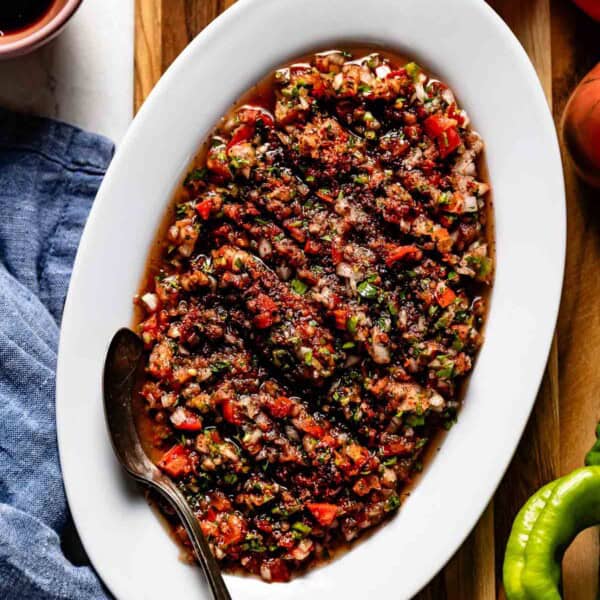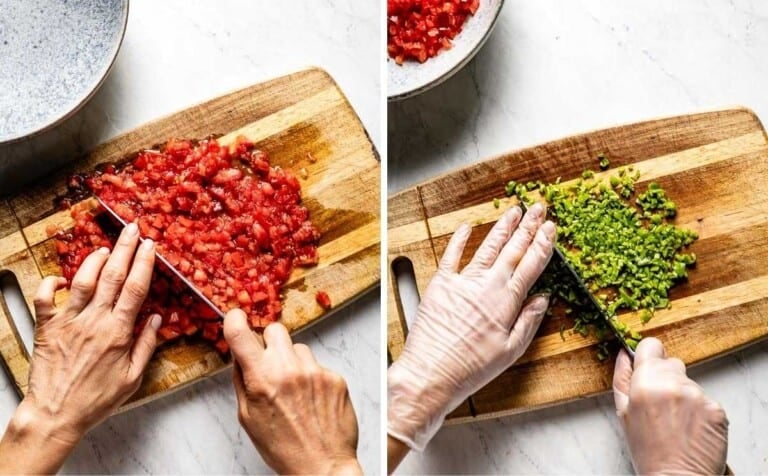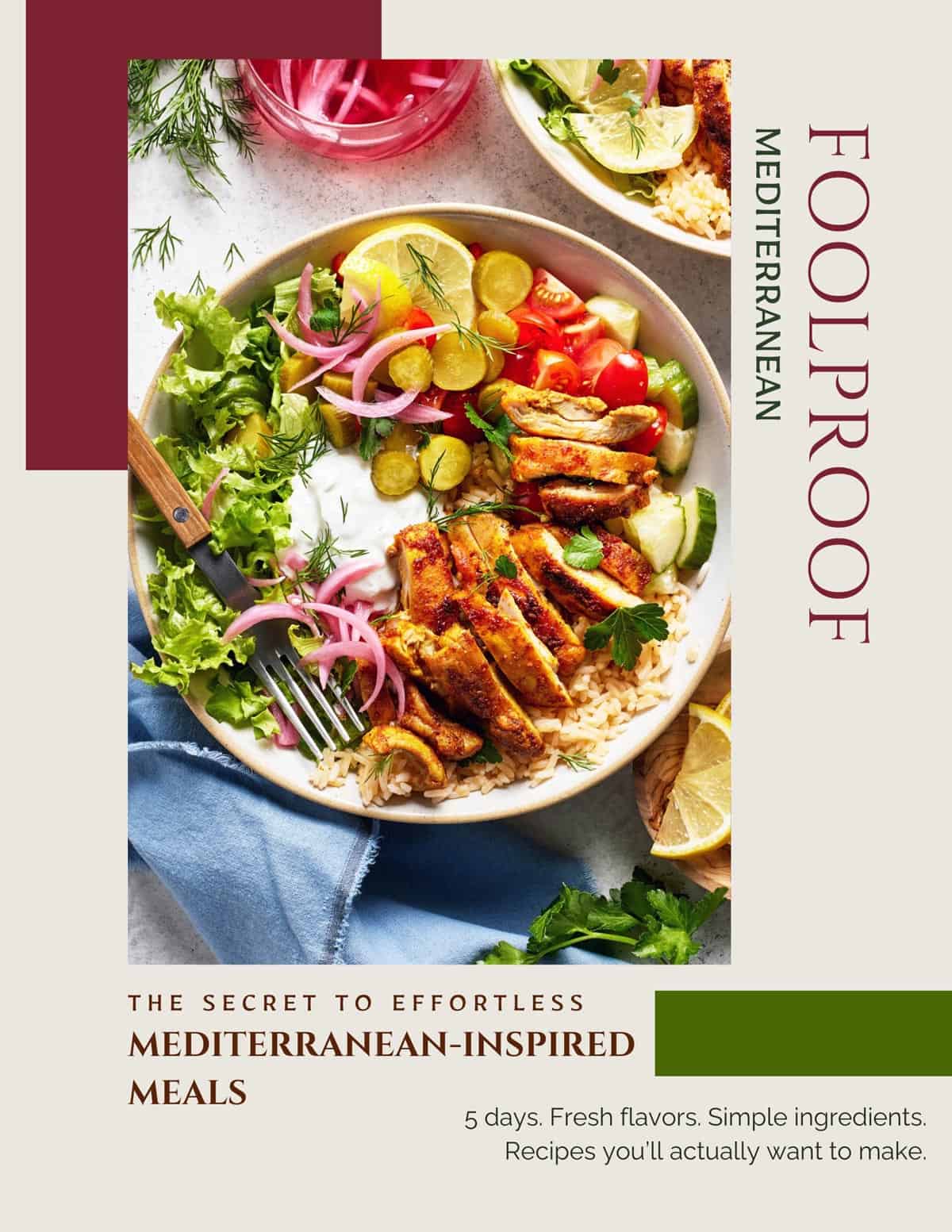What Is Turkish Ezme?
Ezme is a finely chopped Turkish tomato salad or dip that you can make in 10 minutes. Today, I’m sharing my mom’s version, along with the tips I’ve learned from her, to make it authentically spicy or more gentle.
This year, I made it my mission to share some of my favorite kebab recipes, and you simply can’t talk about kebabs without mentioning their ultimate pairing: Turkish ezme.

Pronounced exactly as it looks, this bright tomato salad (or dip) is one of the most authentic dishes you’ll find alongside kebabs in Turkey.
Often described as a Turkish “salsa” by those trying it for the first time, for those of us who grew up with this simple dish, Turkish ezme is so much more. It’s refreshing, a little spicy, and the perfect companion not only to kebabs but to any grilled meats.
Originating from the regions best known for their kebabs, Gaziantep, Urfa, Adana, and Mardin, Turkish ezme is a staple that’s deeply woven into the kebab tradition. Each region puts its own spin on it; Gaziantep’s version (referred to as Antep Ezme) is usually spicier, while Urfa’s might lean more tomato-forward.
If you’ve ever been to a kebab restaurant, you’ll know what I mean. The moment you order, they don’t ask whether you’d like ezme on the side. They just bring it, often with a side of lavash or pita bread for scooping, along with other staples like cacik (pronounced ja-juk, aka the Turkish cousin of tzatziki) and hummus. It’s part of the ritual, and to me, it’s as essential as the kebab itself.
Traditional Turkish ezme is made with finely chopped onions, ripe tomatoes, and peppers mixed with red pepper paste, lemon juice, and a handful of spices.
Depending on how it’s prepared, it can be spicy (called Acılı Ezme) or more mild if you remove the seeds of the peppers or cut back on the red pepper flakes.
Ingredients You’ll Need & Why They Matter
The ingredients in Turkish Ezme dip are simple, fresh, and rooted in the flavors of the Eastern Mediterranean. While it uses everyday ingredients, there are some nuances that I’d like to share to ensure your version is as close to the original.
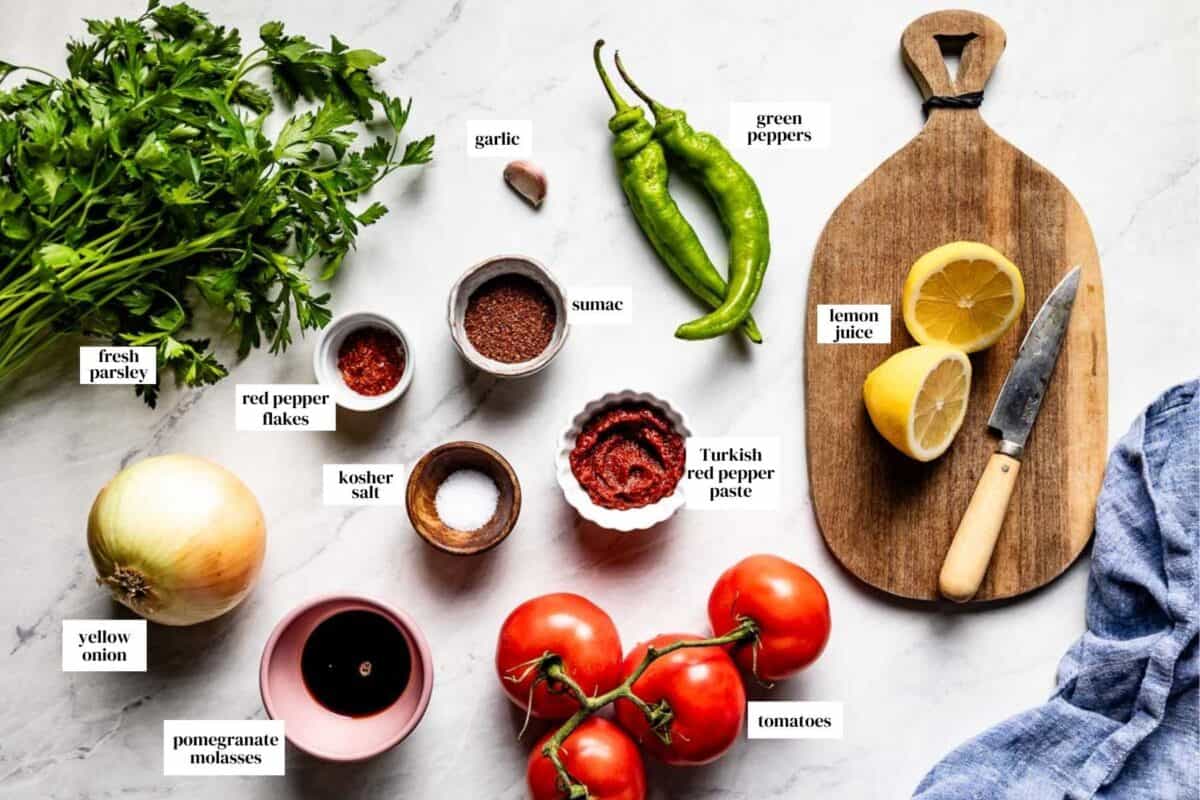
Yellow Onion: Traditional Ezme is made with yellow or white onions. At first, a whole onion may seem like a lot, but once it’s finely chopped and mixed in, it melts into the salad and gives just the right balance.
While not traditional, red onion would also work, but it would have a slightly sweeter flavor.
Garlic: The authentic version of this Turkish dipping sauce does not use garlic, but my mom always did, so I am following in her footsteps. That small tweak is what makes my family’s version unique. It can be omitted if you are a purist.
Kosher Salt: I use kosher salt not only to flavor the overall ezme but also to soften the chopped onion and garlic. It also helps mellow their sharp, raw flavors.
Tomatoes: Authentic Turkish ezme is traditionally made with tomatoes from the Southeastern region of Turkey. Because of the hot, dry climate, those tomatoes are less juicy than what we often find here in the US.
For the best results, use firm, not overly ripe, tomatoes such as Roma, heirloom, or even cherry tomatoes. Whatever you choose, it’s important to remove the seeds.
Ezme should be juicy enough to scoop up with bread but not watery. If taking the seeds out feels like too much work, you can chop the tomatoes finely and strain them briefly through a fine mesh sieve to get rid of the excess liquid.
In the winter months, when good tomatoes are harder to come by, some people turn to canned whole peeled tomatoes. While that can work in a pinch, I find the taste of fresh tomatoes makes the biggest difference in capturing the true spirit of ezme.
Green Peppers: The authentic recipe uses Turkish sivri biber. The name literally means “pointed pepper,” and that’s exactly what it looks like: long, thin, and tapering to a point.
Since I cannot get my hands on sivri biber here in the US, I use Anaheim, jalapeno, or serranos as an alternative. I remove seeds to keep the spice levels mild, but if you prefer yours spicy (and want to make an acili ezme recipe, as we say in Turkish), feel free to keep some.
Red Pepper Paste (or Tomato Paste): Red pepper paste is yet another traditional ingredient used in most kebab and meze recipes. I buy mine online. Tukas’s red pepper paste is my favorite. However, tomato paste is a good substitute.
Lemon Juice: Freshly squeezed lemon juice is the best, but if bottled juice is all you have on hand, that would work in a pinch.
Fresh Herbs: I kept the recipe simple and only used fresh parsley, but my mom always added a few tablespoons of chopped fresh mint and dill in addition to parsley. If you are growing your own herbs, this is a fantastic recipe to put them to good use.
Sumac: A sprinkle of sumac is the finishing touch for this Turkish salad. I buy sumac online, but you can find it in the Middle Eastern/Mediterranean section of your grocery store. If you can’t get your hands on it, you can omit it. Your salad will still taste great.
Urfa Chili Pepper (or Aleppo Pepper or Red Pepper Flakes): For a smoky finish, use the traditional Urfa chili (Urfa biber). If you prefer a bit more straightforward, less smoky, bright finish, use Aleppo chili (Pul biber). If you do not have either of those, a pinch of any red pepper flakes you have on hand would also work.
Optional Add Ins:
Classic Turkish ezme is usually made with the ingredients I listed above, but depending on the region and sometimes the creativity of the chef, you will find different variations. The add-ins below are not traditional in every version, but they are wonderful ways to build on the base and make it your own.
Pomegranate Molasses (optional): You’ll often see restaurants finish off this Turkish red sauce with a drizzle of pomegranate molasses, especially if they are serving it as a part of a meze platter.
While it is an optional ingredient in this recipe, if you are into Mediterranean cooking, I highly recommend investing in a bottle. It provides a unique depth, a fruity tartness that can’t be replicated with just lemon juice.
When shopping for pomegranate molasses, look for a brand that lists only one ingredient: pomegranate concentrate. That way, you’ll get the purest taste without added sugar or preservatives. The one I always buy online is Eastanbul.
Olive Oil: A tablespoon (or two) of olive oil drizzled at the last minute makes it richer. I recommend an extra virgin olive oil that is mild in flavor, such as Garcia de la Cruz.
Walnuts: A close cousin of Turkish ezme is a dish called Gavurdağı Salatası. In some parts of Turkey, it’s common to add a handful of chopped walnuts, which makes the salad richer and adds a pleasant crunch. You can mix them in with the vegetables or simply sprinkle them on top as a garnish.
Pomegranate Seeds: For a beautiful pop of color, a juicy burst of sweet-tart flavor, and a delicate crunch that makes the dish feel even more special, you can add (2 tablespoons) pomegranate seeds.
How to Make Turkish Ezme?
Making this authentic recipe is surprisingly simple, and it all starts with fresh, high-quality ingredients. This Turkish dip gets its signature texture from chopping everything very finely by hand, which gives the salad its unique, crushed consistency. Here is how I make it in my kitchen:

Step 1 – Mince and Soften the Aromatics: On a large cutting board, finely chop the onion and garlic. Sprinkle them with kosher salt and gently knead the mixture with your hands.
Adding the salt not only helps soften the raw onions but also mellow their sharpness. Transfer the mixture to a medium-size mixing bowl.
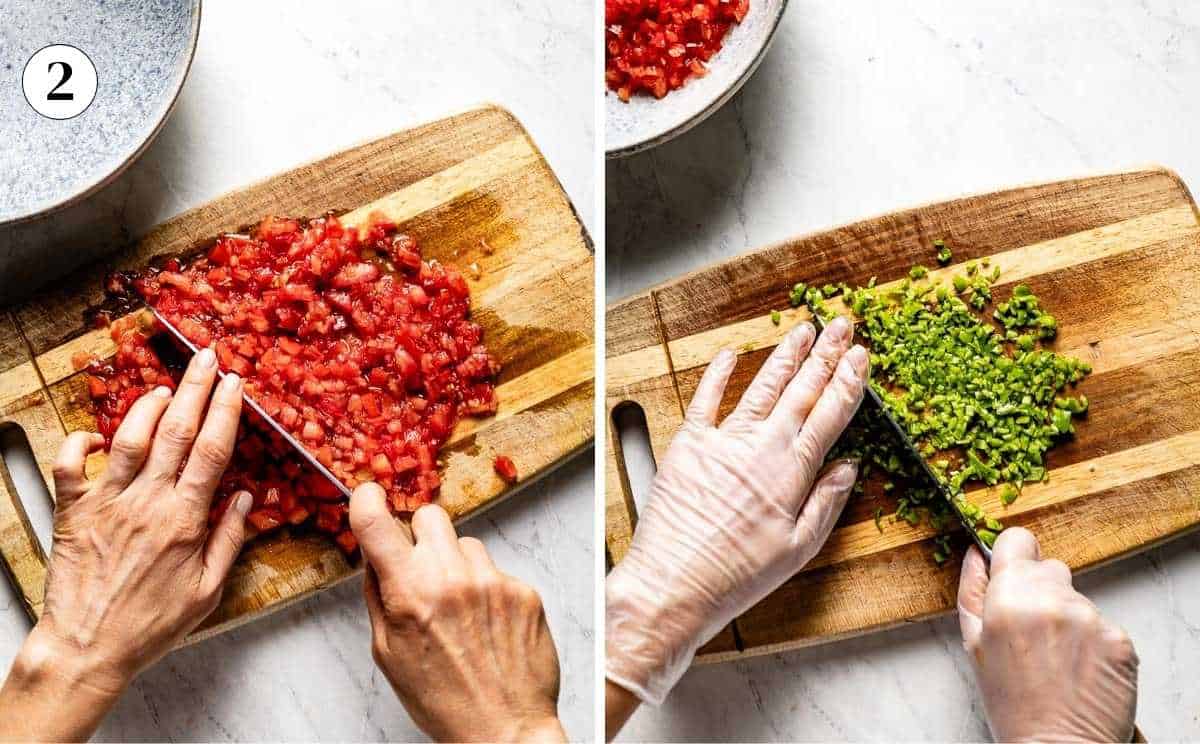
Step 2 – Add the Fresh Vegetables: Using a sharp knife, carefully remove the seeds from the tomatoes and chop them finely. If you’d rather not fuss with seeding, chop them and give them a quick press through a fine mesh sieve to remove the extra liquid.
Next, remove the seeds from your peppers and chop them as finely as possible. When cutting peppers, I highly recommend wearing gloves if you have them. The oils can cause a burning sensation on your hands and sting really badly if you accidentally touch your eyes.
Transfer the tomatoes and the peppers to the bowl. Some cooks use a food processor for convenience, but I find it’s easy to over-process and end up with more of a puree of vegetables. I think hand chopping is worth the effort, especially if you are looking for the most authentic version of this Turkish red sauce.

Step 3 – Mix in the Flavorings: Stir in the red pepper paste (or tomato paste), lemon juice, chopped parsley, sumac, and Urfa chili flakes (if using).
Step 4 – Thoroughly Combine: Using a large spoon, gently mix everything together until all the ingredients are well incorporated and evenly coated. Don’t rush this step, as ezme should feel like one unified mix, not separate vegetables.
Step 5 – Finish and Serve: You can serve it straight from the bowl, but if you want to do it the way we do it in Turkey, then transfer it to a small to medium-sized oval plate. Drizzle with pomegranate molasses or olive oil (if using) and serve right away, ideally with some warm pita or lavash on the side.
Make Ahead and Storage Tips
Make Ahead: This Turkish dip actually tastes even better after it has rested. I often make it a few hours in advance and let it chill in the fridge so the flavors can deepen and meld.
Keep in mind that the juices will settle as they sit, so you may have to drain them before serving.
Storage: Leftover ezme keeps well for 2-3 days when stored in an airtight container in the refrigerator. Just be sure to give it a good stir before serving, and again, drain the juices as needed.
Freezing: This dish is best when enjoyed fresh, so I do not recommend freezing it as it will lose its signature texture when thawed.
Expert Tips from My Turkish Kitchen
Use a fine mince when chopping by hand: The secret to ezme’s classic texture is how finely everything is chopped. You don’t want big chunks in there. Take your time when chopping; it is part of what makes this recipe so good.
Dealing with excess juice: Earlier, I mentioned removing the seeds from the tomatoes to get the authentic texture that ezme is known for. But if you don’t mind some extra juice, that’s perfectly fine too. It will still taste fresh and delicious.
Using a food processor: My mom would probably turn in her grave if she saw me recommending a food processor when making ezme. Traditionally, everything is chopped by hand, and I still believe that’s the best way to get the right texture. That said, I know it can be a real time-saver, especially if you’re making a big batch.
If you do decide to use one, here’s what I recommend:
- Start with the harder vegetables (onions, garlic, peppers) and chop them finely before adding the softer tomatoes.
- Once you add the tomatoes, use short pulses instead of running the machine continuously. This helps you avoid ending up with a puree and keeps that slightly crushed consistency that makes ezme special.
Make it your own: Once you’ve made the basic recipe I shared below, try creating your version by adding a bit more heat (there is a reason people ask for ‘acili ezme’, the spicy version of this dish) or incorporating some of the optional ingredients I mentioned above.
How to Serve Turkish Ezme (The Ultimate Kebab Side Dish)
Ezme is one of those dishes that goes with almost everything. While it’s a classic alongside kebabs, its fresh, tangy flavor also makes it a great match for other Mediterranean favorites, from grilled meats to mezze platters.
- With Kebabs or Grilled Meats: Ezme is the ultimate side to dishes like Adana Kebab or Chicken Kebab. Its acidity and spice help balance the richness of the meat, which is exactly why it’s such a common pairing in Turkey.
- Part of a Meze Platter: Add it to a Mediterranean-inspired mezze platter alongside hummus, baba ganoush, and muhammara. Don’t forget the lavash, Turkish pide bread, or pita bread (or pita chips) for scooping! This dish is meant for sharing.
- As a Spread or Sandwich Topping: Use leftover ezme as a spread for sandwiches or wraps the next day. It’s especially good on my Grilled Lamb Burgers, adding a bright, tangy kick that makes them even more special.
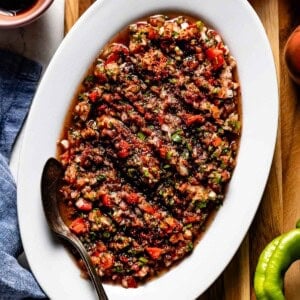
Turkish Ezme Recipe
Ingredients
- 1 yellow onion, medium size
- 1 clove garlic, finely minced
- 1 teaspoon kosher salt
- 4 medium tomatoes
- 2 green peppers, Anaheim, jalapeño, or serrano, seeded
- 1 tablespoon Turkish red pepper paste, or tomato paste
- 3 tablespoons lemon juice, freshly squeezed
- ¼ cup fresh parsley, chopped
- 1 tablespoon sumac
- ¼ teaspoon Urfa chili, Aleppo pepper, or red pepper flakes (optional)
- 2 tablespoons pomegranate molasses, optional
Instructions
- On a large cutting board, finely chop onion and garlic. Sprinkle with kosher salt and knead gently to soften. Transfer to a large bowl.
- Remove the seeds of your tomatoes and give them a fine chop. Alternatively, you can chop them first and strain through a fine mesh strainer to remove the juices. Transfer the tomatoes to the bowl.
- Chop the seeded peppers finely and add them to the bowl.
- Stir in the red pepper paste, lemon juice, parsley, sumac, and chili flakes (if using). Mix well to combine.
- If using, drizzle with pomegranate molasses and serve*.
Notes
- Yields: This recipe makes about 2 to 2 1/2 cups of ezme, which is ideal for serving 4 people. The nutritional values below are per serving.
- Storage: Leftovers will keep well for 2-3 days when stored in an airtight container in the refrigerator.
- *Let it rest before serving: It is optional, but if you have the time, chill it in the fridge for about 30 minutes before serving. This gives the ingredients a chance to mingle and develop deeper flavor. Just keep in mind that it will release some of its juices as it sits, so you may want to spoon out the excess liquid before bringing it to the table.
- Adjusting the spiciness: If you prefer your ezme to be on the milder side, I recommend taking the time to remove all of the seeds of your peppers and avoid using red pepper flakes.
Nutrition
Nutrition information is automatically calculated, so should only be used as an approximation.
FAQ’s
Ezme has a gentle heat, but you can easily control the spice level. If you prefer it mild (or not spicy at all), take the time to remove all of the seeds of your peppers and omit using red pepper flakes.
In Turkey, every region puts its own spin on ezme. In Gaziantep, it’s usually spicier, in Urfa it leans more tomato-forward, and in Adana it often includes extra pepper paste. My mom’s version here is closest to what you would find in kebab restaurants across the country.
Absolutely. If you’re sensitive to acidity, try reducing the amount of fresh lemon juice or skipping the pomegranate molasses. It will still taste fresh and delicious.
As long as it is stored in an airtight container in the refrigerator, it should still be fresh for up to 3 days.
Other Turkish Salads You Might Like:
If you’re already convinced to make this Turkish ezme salad recipe, you’re already on your way to creating a fantastic feast. Here are a few more fresh and delicious Turkish salad recipes to serve alongside your grilled meats:
- My go-to Turkish summer salad, Piyaz, is A zesty and refreshing salad made with white beans, red onions, tomatoes, and parsley, all tossed in a simple lemon-olive oil dressing. It’s a perfect complement to rich, grilled meats.
- For a simple side salad that will pretty much work with any grilled meat and vegetable, look no further than my Turkish Shepherd Salad.
This post may contain affiliate links. If you purchase through these links, I may earn a small commission, at no additional cost to you.
